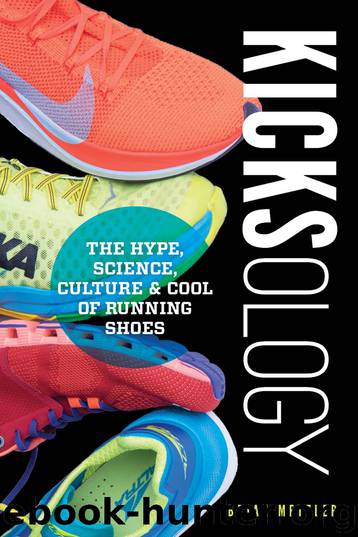Kicksology by Brian Metzler

Author:Brian Metzler
Language: eng
Format: epub
ISBN: 9781948006088
Publisher: VeloPress
Published: 2019-08-15T16:00:00+00:00
In the 1990s, when low-tech video gait analysis became more widely available at running stores, Runner’s Corner was among the first to utilize it for the purpose of understanding the individual running gait patterns of its customers. A runner’s feet and lower legs were videotaped from behind while running on a treadmill, and then a shoe-fit expert would watch the tape in slow motion to determine whether and how much that runner was pronating (rolling inward) or supinating (rolling outward).
For much of the previous 25 years, the running industry had been obsessed with how runners pronated. Studies had long shown that most runners pronate when they run, but how much and how potentially injuriously has always been a wide-ranging debate based on hearsay among form gurus and running shoe marketing directors.
The general idea was that overpronating, especially severe overpronating, led to many of the most common running injuries because it caused additional twisting of the ankles, lower legs, knees, thighs, and hips. While the twisting is a fact, overpronating versus severe overpronating has never been clearly differentiated, nor has a causal relationship to specific injuries been established.
But that didn’t stop shoe companies from taking this so-called calamity and running with it as a sales mechanism.
To solve this supposed gait malady, the thinking went, runners who overpronated needed to be fitted with supportive shoes—a mildly supportive stability model or a highly supportive motion-control model—that would limit the degree of rolling and thus greatly reduce the chance of overuse injuries. The rare runner who didn’t show signs of excessive pronation would be fitted with neutral shoes.
The process was well intentioned but flawed for a few reasons. One, true video gait analysis is effective only with high-speed cameras that can record super-slow-motion images, which was not the tech being used in running stores at the time. Two, and more importantly, the idea was based on the false notion that what was happening at the foot and ankle was the most important aspect of a runner’s gait. The reality is that pronation is a natural movement pattern for many runners, and trying to control it or slow it with a restrictive shoe that was heavy and limiting only caused more problems up a runner’s kinematic chain.
Not surprisingly, Hawk said, the return rate of shoes at Runner’s Corner doubled when the treadmill gait analysis was at its peak and stability and motion-control shoes were being regularly prescribed, as did the number of runners who returned to the store complaining of injuries.
Once those trends became apparent, they removed the treadmill from the store and reverted to teaching runners how to run with good form and be proactive about protecting their bodies from overuse injuries—mainly through form drills, core strength work, greater agility through dynamic stretching, and some barefoot running.
“As soon as we pulled the treadmill out of the equation and started watching people run outside again, the way they normally would, and giving them lessons to run with better form, returns and injuries went way down,” Hawk recalls.
Download
This site does not store any files on its server. We only index and link to content provided by other sites. Please contact the content providers to delete copyright contents if any and email us, we'll remove relevant links or contents immediately.
| Advertising | Annuals |
| Book Design | Branding & Logo Design |
| Fashion Design | Illustration |
| Science Illustration |
Wonder by R.J. Palacio(8465)
Mastering Adobe Animate 2023 - Third Edition by Joseph Labrecque(3775)
Unlabel: Selling You Without Selling Out by Marc Ecko(3591)
Ogilvy on Advertising by David Ogilvy(3512)
Hidden Persuasion: 33 psychological influence techniques in advertising by Marc Andrews & Matthijs van Leeuwen & Rick van Baaren(3474)
Drawing Cutting Edge Anatomy by Christopher Hart(3454)
The Pixar Touch by David A. Price(3364)
POP by Steven Heller(3308)
The Code Book by Simon Singh(3076)
The Art of War Visualized by Jessica Hagy(2945)
Slugfest by Reed Tucker(2942)
The Curated Closet by Anuschka Rees(2915)
Rapid Viz: A New Method for the Rapid Visualization of Ideas by Kurt Hanks & Larry Belliston(2834)
Stacked Decks by The Rotenberg Collection(2812)
365 Days of Wonder by R.J. Palacio(2757)
The Wardrobe Wakeup by Lois Joy Johnson(2733)
Keep Going by Austin Kleon(2696)
Tattoo Art by Doralba Picerno(2600)
Tell Me More by Kelly Corrigan(2591)
